This post explains the difference between Standard, Private and Shared Channels in Microsoft Teams.
Introduction
Microsoft Teams is the enterprise messaging solution in the Microsoft 365, allowing for real time collaboration, communication, meeting, file and app sharing and more.
What is a Microsoft Team?
In a simple way, a Team in Microsoft Teams is a collaboration and communication workspace, allowing a set users to chat, hold meetings and share files and apps with its members or a subset of its members. When a team is created in Microsoft Teams, the following is created:
- A Team in Microsoft Teams
- A SharePoint Site to hold the Teams’s files
- A Microsoft 365 Group that manages access to the team
- An Exchange Online mailbox
- A Shared Calendar
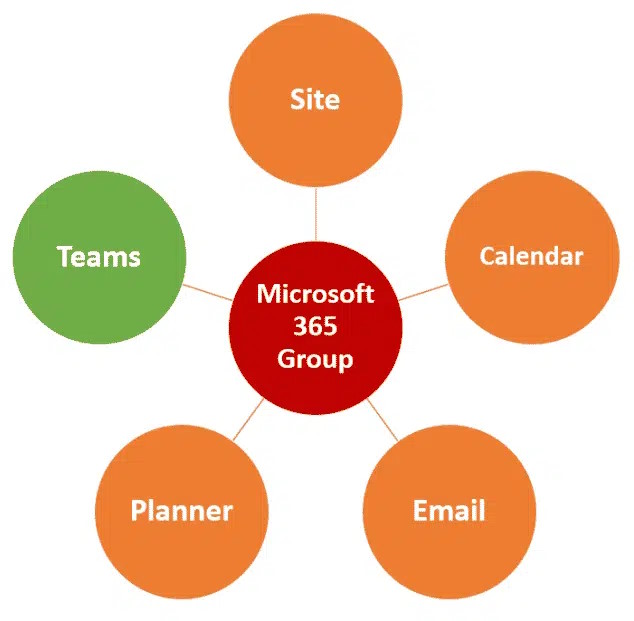
To create a new Team in Microsoft Teams, follow the following steps:
- Select Teams in the left navigation and then +
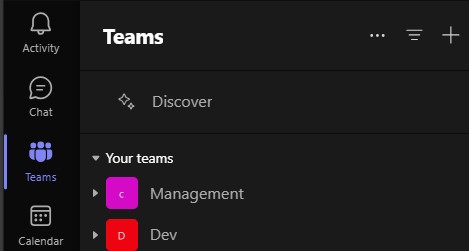

- Give the Team a name and description
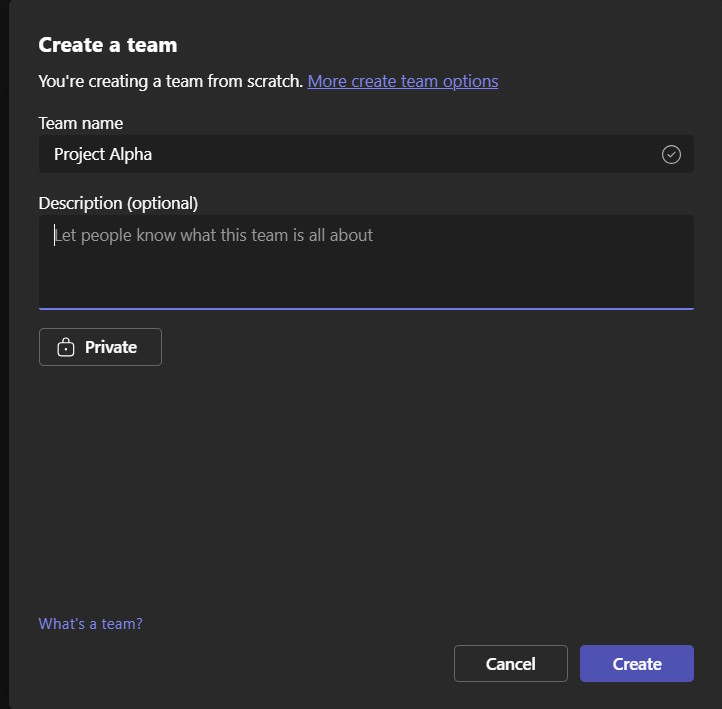

- Add members to the team. In this case, I will add two members, so the Team will have 3 members (the person who creates the Team is automatically added as Owner of the Team).
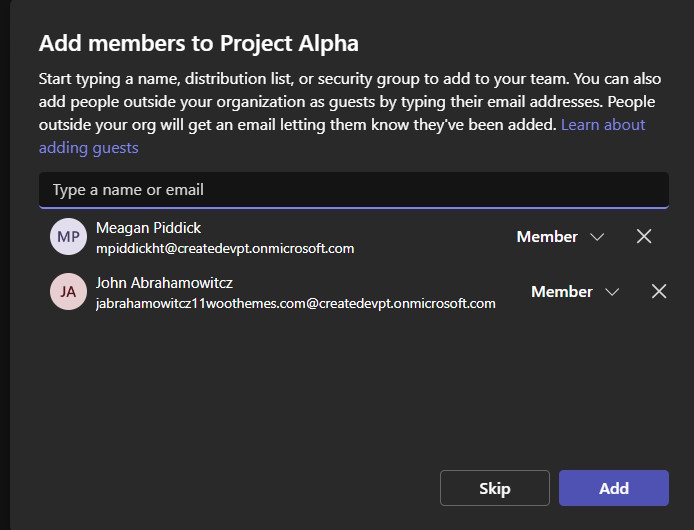

You can also create a plan in Microsoft Planner that allows you to easily manage team projects and tasks.
Focusing on Microsoft Teams, a Team is composed by channels. It is essentially a way to separate conversations and documents within a Team by topic. For example, in a Project Alpha Team, you can have a General channel (default channel created as part of every team), a Management Channel, a Technical channel, etc. In summary, it is a way to separate topics/conversations and its associated documents. There are the three types of channels in Microsoft Teams:
- Standard channels
- Private channels
- Shared channels
In this post, I will explain what each type of channel and what is the difference between them.
Standard Channels
The first type of channel is called a Standard Channel. There is always a Standard Channel called General created by default in Teams when you create a new Team.
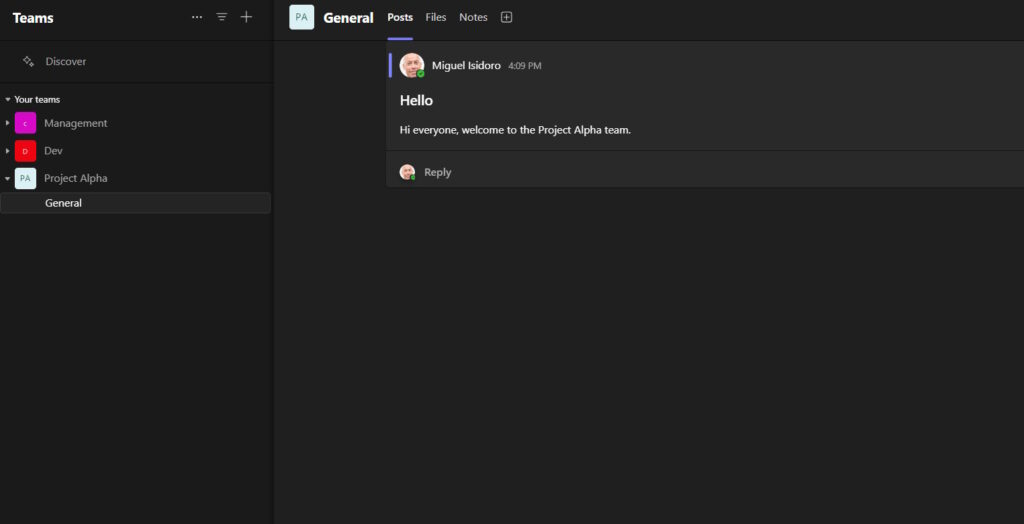

Here is the SharePoint site that was created when the team was created.
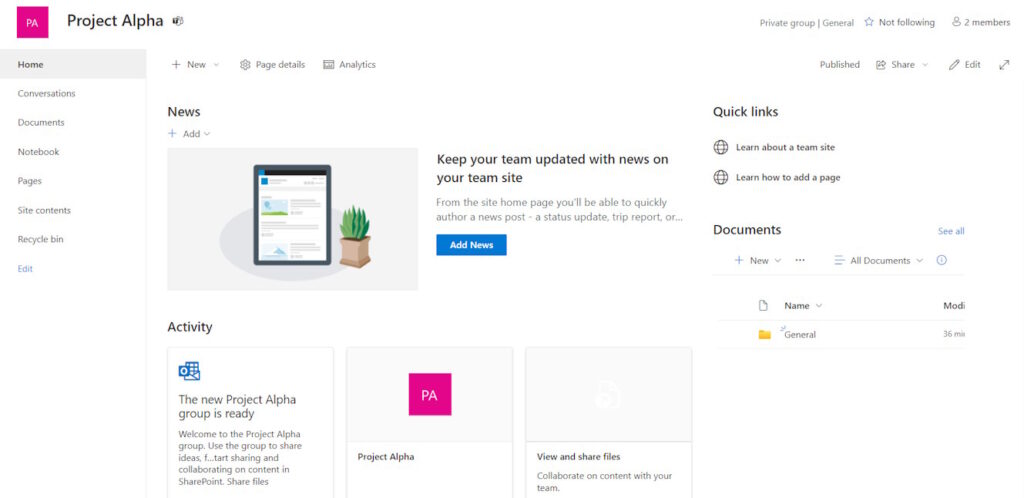

Who has access to a Standard Channel?
A Standard Channel is available to all team members.
Where are documents stored in a Standard Channel?
The documents are stored in SharePoint, in a folder inside the “Documents” document library. For each channel, a folder in the “Documents” document library is created and the files are stored inside that folder.
View of the files in a Channel in Teams:


View of the files in SharePoint:


Private Channels
The second type of channel is called a Private Channel. As I said earlier, Standard Channels are accessible by all Team members, making all the information in those channels (chats and documents) accessible to every team member. There are situations, where you want to discuss sensitive information with just a few Team members instead of the whole Team. This is where Private Channels are handy, allows us to have private conversations and store sensitive documents in a secure way.
To create a Private Channel, follow the following steps:
- Click on the … near the Team name, and then Add channel.
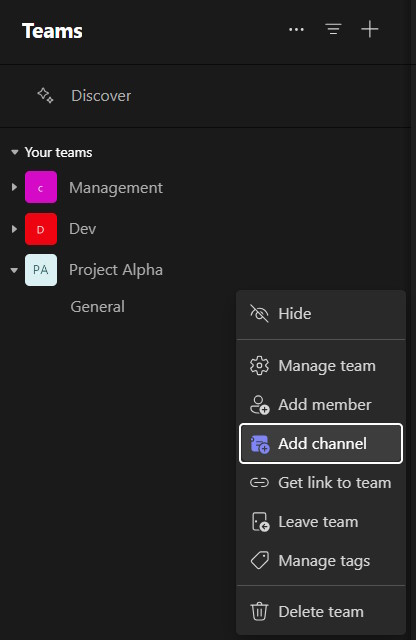

- Give the channel a name select Private in the channel type.
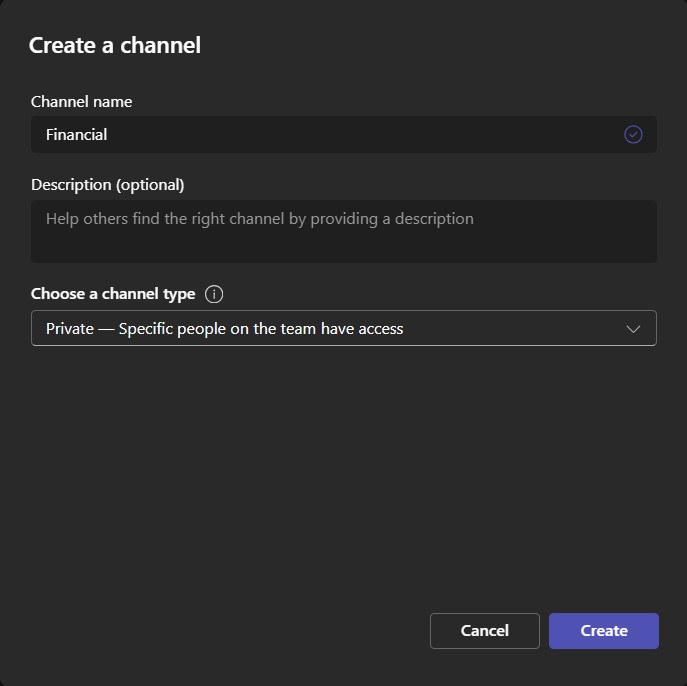

- Add members to the channel
NOTE: In Private channels, you can only add users that are already members of the Team.
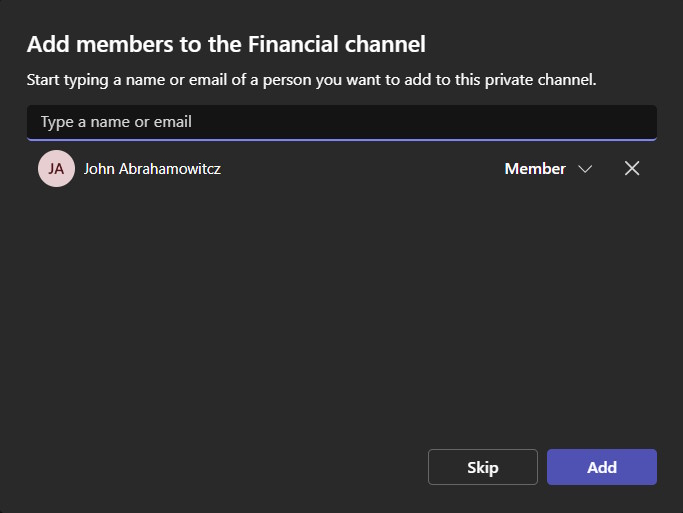

- That’s it. The Private channel is created and is marked with a lock icon.
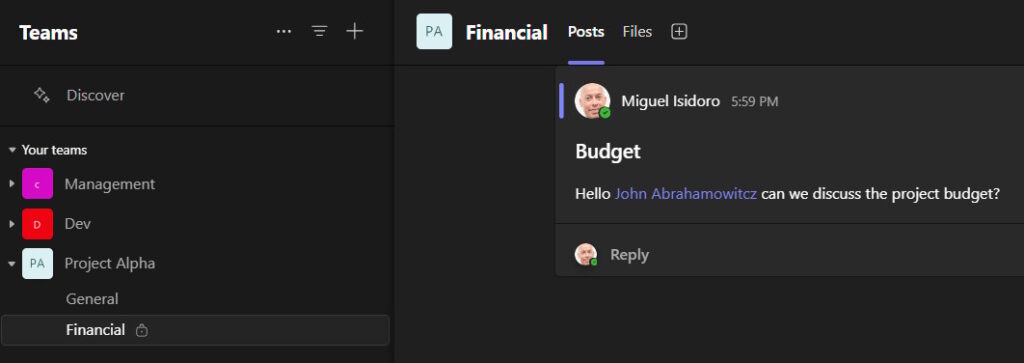

Who has access to a Private Channel?
Only the Private channel members. The channel is not visible to Team members that are not members of the Private channel. We can only invite users that already members of the team, meaning that if the Team members are Meagan and John, I can only invite them and I cannot invite for instance Peter.
Where are documents stored in a Private Channel?
The documents once again are stored in SharePoint but for Private channels, information is stored in a different site than the Team SharePoint site. This was the solution that Microsoft implemented that was the only that guarantees that only the channel members have access to the information in the channel. To access the SharePoint site, click on Files in the private channel and then Open in SharePoint.


As in a Standard Channel, documents are stored in the “Documents” document library, in the folder with the name of the channel.
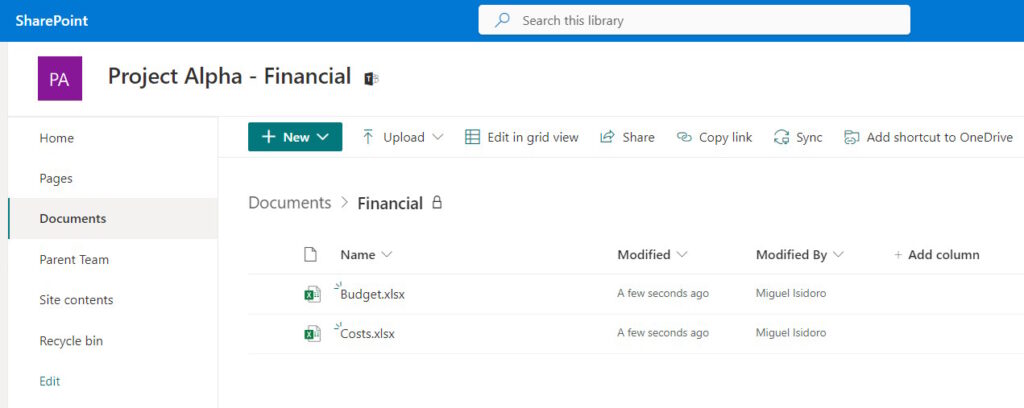

Shared Channels
The third type of channels are called Shared Channels and were introduced due to some limitations in Private Channels. In Private Channels, we can only add users who are already members of the Team which is enough for most cases. However, if you want to discuss a topic with just a few Team members and users that are not members of the Team, this is not not possible using Private channels. This is where Shared channels are handy, allows us to have private conversations and store private documents in a secure way with a restricted set of users but allowing us to collaborate with users outside the Team. Before Shared channels, if you had a use case like this, you would have to create a new Team with all the users you want to collaborate and give them access to the Team’s standard channels, associated SharePoint site, Email, Calendar and Planner.
Because all of this, we now have the Shared channel type, which is similar to Private Channels with the possibility of adding members that are not part of Team.
To create a Shared Channel, please follow the following steps:
- Click on the … near the Team name, and then Add channel.
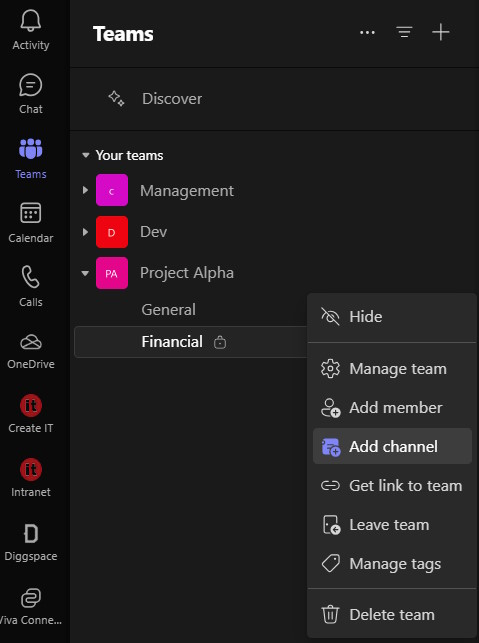

- Give the channel a name select Shared in the channel type
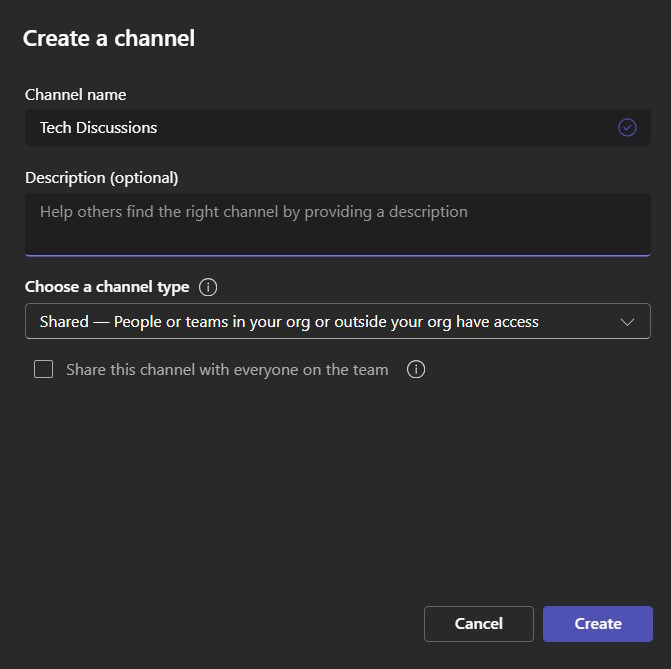

- Add members to the channel
NOTE: In Shared channels, you can add users that are not members of the Team.
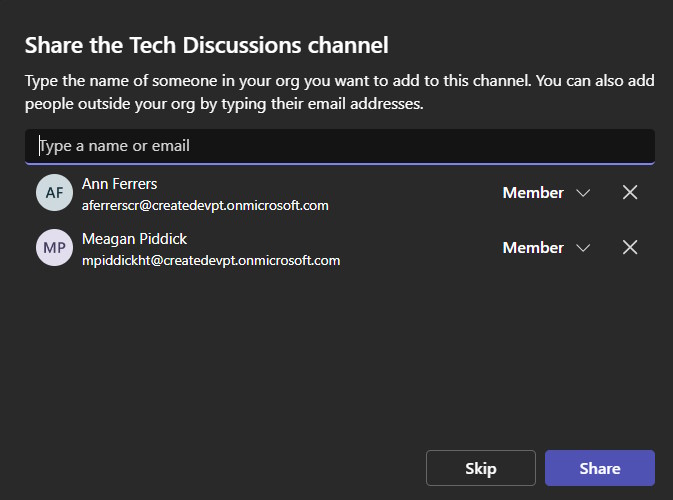

- That’s it. The Shared channel is created and is marked with a “shared” icon
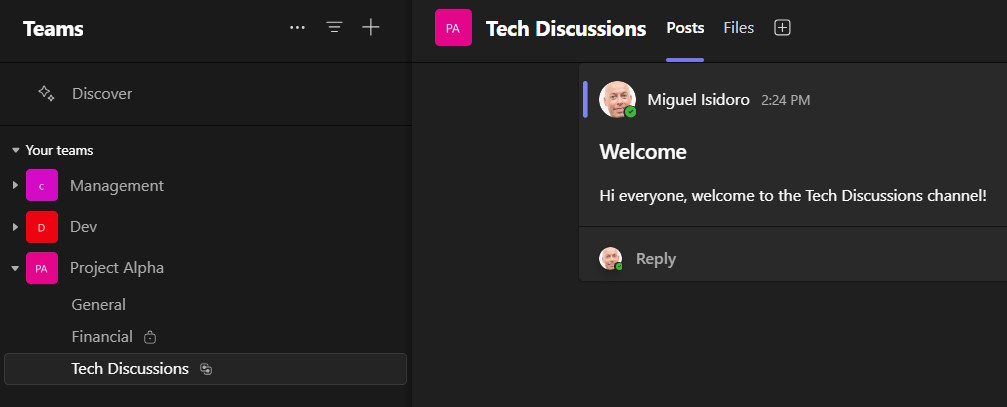

Who has access to a Shared Channel?
Only the Shared channel members. The channel is not visible to Team members that are not members of the Shared channel. In many ways, the concept is similar to Private channels but with the possibility of adding members outside the Team.
Where are documents stored in a Shared Channel?
For Shared channels, documents are stored in the exact same way documents in a Private channel are stored, in a separate SharePoint site for the same security reasons mentioned for Private channels. To access the SharePoint site, click on Files in the shared channel and then Open in SharePoint.


As in Standard and Private channels, documents are stored in the “Documents” document library, in the folder with the name of the channel.
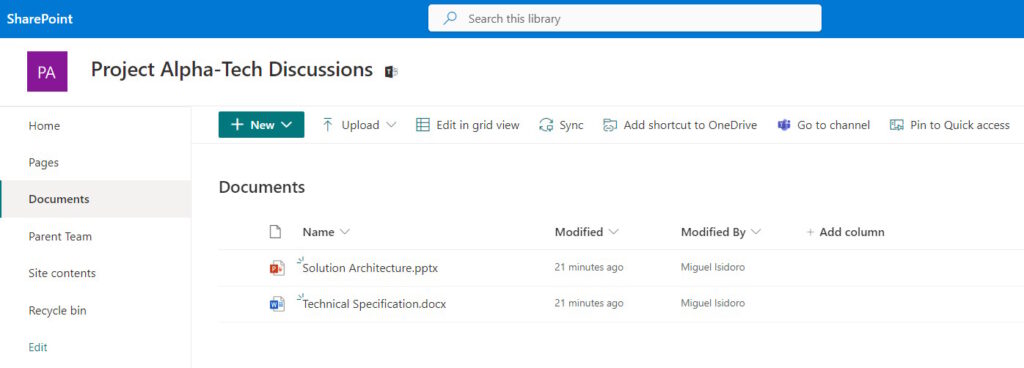

Standard vs Private vs Shared Channels
| Channel Type | Who has access to the Channel? | Where are documents stored? | What Resources do users have access to? |
| Standard | All team members | In the Team’s associated SharePoint Site. | All resources of a Microsoft 365 Group (Team, SharePoint Site, Email, Calendar, Planner) |
| Private | Channel members. Channel members must be members of the Team. | In a separate SharePoint Site that is only accessible by the members of the channel. | Team, SharePoint Site |
| Shared | Channel members. Channel members can be members outside the Team. | In a separate SharePoint Site that is only accessible by the members of the channel. | Team, SharePoint Site |
Related Articles
To learn why your business should migrate to SharePoint Online and Office 365, click here and here.
If you want to learn how to develop SPFx solutions, click here.
If you want to learn how you can rename a modern SharePoint site, click here.
If you want to learn how to save time time scheduling your meetings, click here.
If you want to learn how to enable Microsoft Teams Attendance List Download, click here.
If you want to learn how to create a dynamic org-wide team in Microsoft Teams with all active employees, click here.
If you want to modernize your SharePoint classic root site to a modern SharePoint site, click here.
If you are a SharePoint administrator or a SharePoint developer who wants to learn more about how to install a SharePoint 2019 farm in an automated way using PowerShell, I invite you to click here and here.
If you learn how to greatly speed up your SharePoint farm update process to ensure your SharePoint farm keeps updated and you stay one step closer to start your move to the cloud, click here.
If you prefer to use the traditional method to update your farm and want to learn all the steps and precautions necessary to successfully keep your SharePoint farm updated, click here.
If you want to learn how to upgrade a SharePoint 2013 farm to SharePoint 2019, click here and here.
If SharePoint 2019 is still not an option, you can learn more about how to install a SharePoint 2016 farm in an automated way using PowerShell, click here and here.
If you want to learn how to upgrade a SharePoint 2010 farm to SharePoint 2016, click here and here.
If you are new to SharePoint and Office 365 and want to learn all about it, take a look at these learning resources.
If you are work in a large organization who is using Office 365 or thinking to move to Office 365 and is considering between a single or multiple Office 365 tenants, I invite you to read this article.
If you want to know all about the latest SharePoint and Office 365 announcements from Ignite and some more recent announcements, including Microsoft Search, What’s New to Build a Modern Intranet with SharePoint in Office 365, Deeper Integration between Microsoft Teams and SharePoint and the latest news on SharePoint development, click here.
If your organization is still not ready to go all in to SharePoint Online and Office 365, a hybrid scenario may be the best choice. SharePoint 2019 RTM was recently announced and if you to learn all about SharePoint 2019 and all its features, click here.


![[FIX] BizTalk Server 2010, 2013, 2013 R2 & 2016 errors “Class not registered (WinMgmt)” or “Access denied”](https://blogit.create.pt/wp-content/uploads/2018/07/access-black-and-white-blur-270514-218x150.jpg)


















Terrific summary Miguel. The other important nuance is whether members added to Standard, Private, and Shared channels also gain access to the General channel including the Files tab. The answer is that as members of the Team, members of Shared and Private channels DO have access to the General channel (as well as to other Standard channels), while those who are members only of a Shared channel DO NOT have access to the General channel.
That is correct Eli. Thanks for pointing that out.